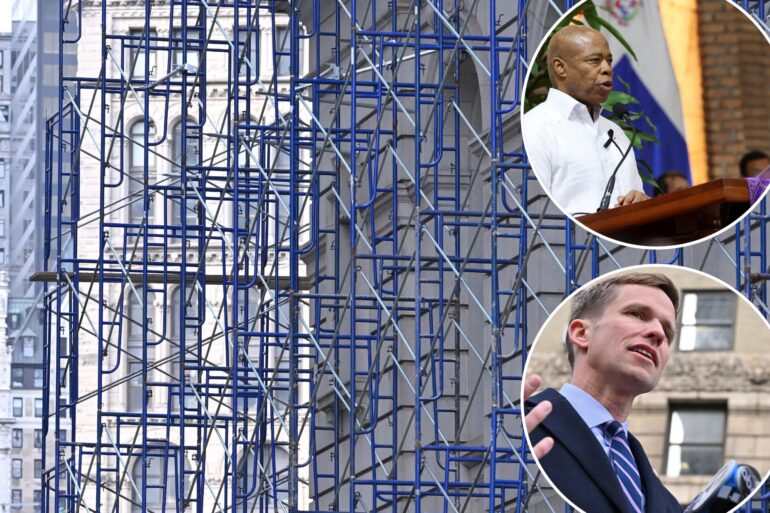🔴 Website 👉 https://u-s-news.com/
Telegram 👉 https://t.me/usnewscom_channel
If you believe the city’s new rules, meant to reduce the number of sidewalk scaffolds, will blow the odious eyesores away, let’s take a stroll together.
Notice that Saks Fifth Avenue’s block-long shed is painted white, Carnegie Hall’s is red, and Burberry’s recently dismantled one was blue.
So what, you say?
Well, new scaffold rules just passed by the City Council will allow “more color options” than the previous rule requiring the use of “ugly hunter green,” as council member Keith Powers, who co-sponsored the changes, put it.
But, ahem! Sidewalk sheds have sported a rainbow of hues other than green for years. Some through curious “exemptions,” others for no clear reason.
If the new legislation is so out of touch with a phenomenon visible to the Big Apple’s 16 million-plus eyes, how seriously can we take the other supposedly transformative rule changes?
Make no mistake: Powers and fellow council member Erik Bottcher deserve credit for taking on the scaffold blight more directly than Mayor Adams did with his mostly-talk “Get Sheds Down” campaign last year.
But the likely impact on the opaque scaffold-rental industry recalls the villain Iago’s taunt when Othello’s sword failed to finish him off: “I bleed, sir, but not killed.”
Tweaking the rules might eventually rid us of the odd monstrosity here or there. But the city’s unique-in-the-world scaffold metastasis won’t go away until/unless infamous Local Law 11, which requires inspections for all buildings taller than six stories every five years irrespective of any risk they pose, is thrown out completely.
Despite repeated city “crackdowns,” the sheds still number about 8,500, only slightly fewer than a year ago.
But even with the recent legislation (which Adams has signed), scaffold-thick areas such as West End Avenue, much of Flatiron, and Downtown Brooklyn will likely remain just as blighted by the crime-breeding, business-killing steel jungles two years from now as they are today.
The sheds still will extend 20 feet in both directions beyond the building under repair, darkening doors and windows of apartment houses, stores, and restaurants that aren’t even under inspection — one of the old law’s most pernicious effects that’s not addressed in the new laws.
Take it from a guy who’s reported on the situation for years and knows well the answerable-to-no-one ways of the loosely run Department of Buildings. This is an office all too willing to wink at or overlook serious violations while lending a veneer of municipal oversight to the multi-billion-dollar scaffold industry.
You’ve heard of the “deep state?” The DOB belongs to the deep city — a knot of municipal agencies that pursue their own agendas and nourish their bureaucracies no matter what the mayor, the council, or courts say.
The DOB even created an absurd spinoff business — inspections of the sheds themselves, a task often delegated to the same hands-out contractors who built them.
Under the new rules, newly constructed buildings won’t need their first inspections for nine years. That’s a step in the right direction. But for all other structures, guess what! Although the uniform five-year inspections requirement is mercifully gone, it’s up to the DOB to decide on the timing.
Powers’ spokesperson Emma Johnson explained, “All buildings [other than new ones] will have inspection cycles between six and twelve years, which DOB will determine.” (Italics ours.)
How and when will the agency make such decisions for our 1 million buildings, even if it acted in the best faith? And when its legions of managers, inspectors, engineers, and consultants depend on “enforcement” for their incomes?
Landlords must renew applications for sheds every three months rather than once every year, or be fined up to $6,000 a month. But for many large landlords, $72,000 a year is still peanuts compared to the costs of facade repairs that often seem never to get done.
New York could learn from Chicago. For all that city’s problems, despite having the nation’s second-largest concentration of large buildings, it’s largely free of the steel-and-wood monstrosities.
That’s because its inspection protocol sensibly divides buildings into four separate categories based on their ages, materials, and conditions. The class deemed safest requires inspections only 12 years apart.
Of course, such a sensible loosening of requirements would mean less dough for the Big Apple’s scaffold peddlers.
Countless landlords and construction executives suspect mob involvement in the scaffold business. They won’t let their names be used as they value the use of both legs.
Prosecutors should listen to them. And City Hall should replace the bad law that plunged much of the “world’s greatest city” into darkness.

